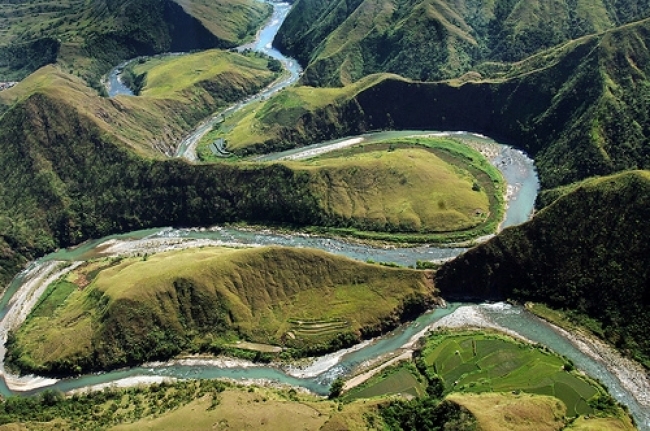
In the overleaf that follows, the breathtaking bird’s-eye view of the winding Alimit River in remote northeastern Ifugao Province on Luzon Island in the Philippines shows how the landscape can be fashioned by nature—and humans. Indeed, the Alimit has carved its way through the mountains for centuries and, as can be seen in the lower right quarter of the centerfold, the Ifugao people have been doing some carving of their own.
Their decades-long, methodical chiseling of the riverbank will eventually help isolate the oxbow from the river’s flow, providing these ingenious engineer farmers a new fertile niche on which to grow their famed Ifugao rice. The photo at right shows the end result of a successful centuries-earlier claiming of the river’s territory for rice growing.
These photos are just two of nearly 1,000 shots made from a small airplane during an early March 2006 expedition by Rice Today photographer Ariel Javellana under the guidance of eminent Yale anthropologist (retired) Harold Conklin. With the fickle weather of Luzon’s Cordillera Mountain Range being unusually cooperative, the adventuresome duo spent many hours flying above the province’s rice terraces, fields, river valleys, mountains, and forests. They documented some 40 years of both change and stability across approximately 80% of the province’s 2,500 square kilometers of rugged topography.
“The Ifugao people do not consider anything immovable,” said Dr. Conklin in admiration of these indigenous people, whom he has studied for more than 4 decades, as he reviewed with Javellana the treasure trove of images they brought back with them to IRRI for study. Dr. Conklin plans to include an analysis of some of the photos in a book he is planning about rice and the Ifugao. Watch for more spectacular photography from this collection in a future issue of Rice Today.
___________________________________________
Mr. Hettel is the editor-in-chief of Rice Today.





